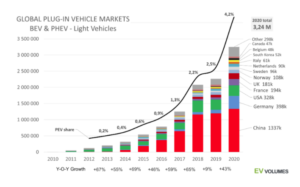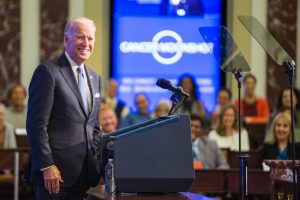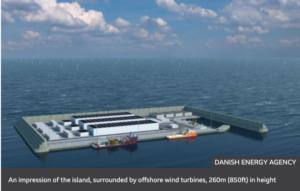In This Issue
- Flanigan’s Eco-Logic: The End of ICE Cars
- Global Electric Vehicle Sales
- A Norwegian EV Shout-Out
- Microgrids 1.3: Two Case Studies
- The United States Rejoins the Paris Agreement
- Farmers Now Paid to Sequester Carbon
- Big Wind Projects in Denmark and South Korea
- The NetPositive Podcast

Flanigan’s Eco-Logic: The End of ICE Cars
General Motors Chairman, Mary Barra, announced on Thursday, January 28th that GM will completely phase out the manufacturer of vehicles using internal combustion engines (ICE) by 2035. It is ahead of the pack committing to phase out all gas and diesel for light-duty vehicles, cars, pickups, and SUVs. GM plans to invest $27 billion in electric and autonomous vehicles by 2025. It’s the end of ICE cars!
Internal Combustion Engines (ICE) have served us well for some 160 years, powering our cars, planes, ships, and more. Karl Benz had the patent for the world’s first car powered with a gas combustion engine in 1886. Today, however, ICE cars are nearing extinction, obsolescence is on the horizon. Powerful and macho… they don’t work well in a carbon-conscious world. Internal combustion engines have four strokes: intake, compression, power, and exhaust. The last spells their demise. Meanwhile, Bloomberg NEF reports that the cost of batteries for electric vehicles (EVs) has dropped 87% from 2010 – 2019. The writing is on the wall as one technology falls and the other rises.
GM wants market share in the growing EV space, and is no doubt keen on tackling Tesla while fending off other EV upstarts including Rivian. GM produced its first “long-range” battery electric vehicle in 2016, the Bolt. It has been competing nicely with the Tesla Model 3; the Bolt being sold at less cost while offering similar performance. GM is working in partnership with LG Chem to drive down costs further. By opening a new plant in Ohio to manufacture its new Ultium batteries, GM hopes to cut the costs of its Bolts by another $4,000.
GM is not the only car maker making bold statements: In early February, Ford announced that it will invest $29 billion in EVs and autonomous vehicles by 2025. It too aims to compete with Tesla in the race to bring EVs into the mainstream. By 2030 Ford will only produce all-electric and plug-in hybrid vehicles. An electric version of Ford’s cash cow, the F150 pickup truck, will go into production next year.
Other automakers are moving away from ICE. Bentley laid out a target date of 2030 to switch entirely to battery electric vehicles. Nissan will electrify all vehicles by the early 2030s. In early February, Jaguar announced that it will only produce electric vehicles by 2025. Its owner, Indian Tata Motors, reportedly hopes the move to all-electric will turn around the struggling 86-year-old car company’s fortunes.
The end of ICE is being driven by technology and policy. EVs are fun to drive and are more and more affordable to buy. There are many models available. They are low-cost to operate and require no maintenance. Their growth and speed of their adoption, however, are still dependent on government decrees. At the beginning of 2021, there were 31 national and local governments that had announced bans on the sale of cars with internal combustion engines. A list compiled by Charged Future runs from Norway to South Korea, Slovenia, and India. Some governments regulate fleets, other regulations are just for new vehicles. Norway will ban ICE cars by 2025; the United Kingdom, Iceland, Ireland, Sweden, and the Netherlands by 2030.
American states with ICE bans include California, Colorado, Washington, New Jersey, and the District of Columbia. There will be more to come. All these above are reactions to the climate imperative – to clean our tailpipes – and to the sharp rise in EV sales and Tesla’s success.


 Norway, a Scandinavian nation with a population of just over 5 million, is leading the EV revolution by selling more EVs per capita than any other country. Why? Despite being a major oil-producing nation, the Norwegian government has developed strong incentives for decarbonizing transportation by utilizing the country’s carbon-free hydroelectricity resources.
Norway, a Scandinavian nation with a population of just over 5 million, is leading the EV revolution by selling more EVs per capita than any other country. Why? Despite being a major oil-producing nation, the Norwegian government has developed strong incentives for decarbonizing transportation by utilizing the country’s carbon-free hydroelectricity resources.

 On Friday, February 19th, the United States officially rejoined the Paris Agreement. Following United Nation rules, that’s 30 days after a letter from President Joe Biden the day of his inauguration stating his decision for America to immediately re-join the global accord. That’s good news, the implications of which were made clear by Dr. Robert Kay of ICF Consulting in a recent webinar.
On Friday, February 19th, the United States officially rejoined the Paris Agreement. Following United Nation rules, that’s 30 days after a letter from President Joe Biden the day of his inauguration stating his decision for America to immediately re-join the global accord. That’s good news, the implications of which were made clear by Dr. Robert Kay of ICF Consulting in a recent webinar. Farmers are finding a new source of income: carbon sequestration. By adopting new planting strategies, carbon can be captured and returned to the soil. It’s part of a movement called regenerative farming. A Nature Conservancy study focuses on a particular type of no-till farming. It involves the planting of cover crops and nutrient-dense root vegetables during the off season. This technique alone could sequester as much as 10% of the world’s carbon footprint.
Farmers are finding a new source of income: carbon sequestration. By adopting new planting strategies, carbon can be captured and returned to the soil. It’s part of a movement called regenerative farming. A Nature Conservancy study focuses on a particular type of no-till farming. It involves the planting of cover crops and nutrient-dense root vegetables during the off season. This technique alone could sequester as much as 10% of the world’s carbon footprint.
 EcoNet News is now also in podcast format. You can download The NetPositive Podcast on Spotify, Google, and Apple podcast platforms. Sign up if you’d rather hear the news than read it!
EcoNet News is now also in podcast format. You can download The NetPositive Podcast on Spotify, Google, and Apple podcast platforms. Sign up if you’d rather hear the news than read it!